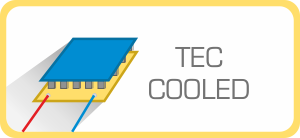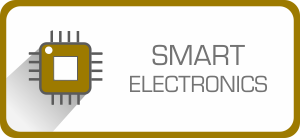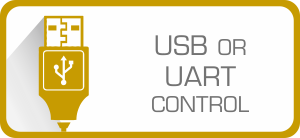Laser Cost: What Makes It Expensive?

From time to time we get inquiries from potential customers asking for two or even four times cheaper lasers. In general, the products of Integrated Optics are considered as an extreme value for money. If similar performance of lasers is compared, IO products are approx. 20% to 30% more cost efficient than competitors in Europe or US. But still some prospects are comparing potatoes to tomatoes expecting for large discounts. In this article we discuss key components, which constitute the cost of a cw laser source in order to understand what's what.
Laser Platform Design

The most obvious distinction between a research grade laser and an industrial pointer is the thermal management principle. Pointer type devices usually have conduction cooling where the laser diode is in good thermal contact with the body, which usually is in a shape of a circular rod.
High performance CW lasers have a Peltier cooler, otherwise - a TEC. This cooling aggregate has two ceramic plates and thermoelectric crystals in between them. Running a current on these crystals makes one ceramic plate to heat and the other one to cool. This is how the temperature of the laser diode or a DPSS cavity is kept constant. This adds great amount of stability of different parameters, such as the output power, beam shape or wavelength stability. Also, this is the only viable way to do spectrally stabilized or single-longitudinal mode (SLM) units.
TEC itself is a matter of 20-30 EUR for the most high end ones. But its installation is labour consuming and to be driven it requires extra power electronics, microcontrollers to run the PID stabilization algorithms and thermocouples at the right spot to sample the temperature of a laser diode. TEC control constitutes a considerable part of the laser firmware as well.
Yet in DPSS lasers additional TEC are usually installed for temperature control of non-linear crystals.
Change of Parameters

Cylindrical lasers are mostly designed to be operated at constant parameters and change of power is often not possible. Since it is a not thermally stabilized unit, change of laser diodes temperature is also not possible, thus there is no advantage of wavelength compensation.
Scientific grade, thermally and optically controlled laser modules do not only have this feature, but also makes it possible to change the optical power and compensate the apparent wavelength shift with change of diodes temperature.
This is particularly relevant In some applications, e.g. dielectric cut-off or laser line cleanup notch filters are used. In case a filter has a lobe where the transmission changes as a function of spectrum, a wavelength change of the laser results in power change after the filter. In these situations wavelength correction with change of diode's temperature is very useful and sometimes indispensable.

A laser module, which has an integrated microprocessor, can be arranged for automated wavelength calibration upon change of power to maintain the same parameters. Such change can be often performed using a USB or RS232 control interface. Not only that.
Microprocessor-equipped units can support optical power calibration, current monitoring, overheat protection and reporting, operational hours counter and many more smart features. All these features are either readily installed or can be arranged on request in the MatchBox2 series of lasers.
Optical Power Stabilization

Very basic pointer type lasers usually have constant current operational mode called automatic current control or ACC. In this mode no optical feedback is used and some drawbacks are obvious:
- Laser diode efficiency changes upon change of the temperature
- Laser optical power tends to drop over time as the diode ages
- There is no signal of failure if the diode fails
Typically one can expect long term power stability of 5-10% or worse over 24 hours on usual operational conditions where the optical power and temperature is not somehow stabilized.
More sophisticated pointer designs use internal photodiode of the laser diode (some laser diodes do have it integrated behind the semiconductor chip) as an optical reference. In this case the laser runs in automatic power control or APC mode. This is much more advantageous than the ACC approach, but still if the temperature of the diode is not actively stabilized, the photodiode response is subject to dependence on temperature. Stability of such concept is typically within 2-5% RMS over 24 hrs. Medium performance CW lasers monitor scattering from optical components with a free-standing photodiode. If the photodiode is thermally stabilized or at least temperature drift is minimized, such sampling delivers satisfactory results. However, stability might suffer quite a lot whether the laser beams tends to move or change its shape. This is particularly relevant when it comes to spatial mode hoping or poor beam pointing stability. After a mode hop, the beam moves slightly and more or less scattering is created and delivered to the monitor photodiode.
The top-performance CW lasers all have an external beam sampler, which is arranged in front of the laser diode, on a collimated beam. It reflects part of the radiation into a photodiode. If done correctly, such sampling method ensures <1% RMS stability over a period of 24 hrs.
The polarization of a laser diode is also a widelly known issue. Thermal or mechanical stress on the laser diode and back-reflections from glossy samples and optics in the optical path can cause the polarization of the laser diode to rotate slightly.
Such change in the polarization direction turns into power fluctations at the sample, whether polarizers or polarization-dependent angle mirrors are used in the optical path. To overcome this Integrated Optics installs polarizing cubes in each diode laser and samples the optical power after the polarizing cube. Many customers already appreciated the benefits of unprecedented polarization contrast (more than 1000:1) and superior power stability in optical setups having polarization-dependent components.
A separate topic is stabilization of VBG stabilized diode lasers or in general external cavity diode lasers (ECDL). Most single-frequency laser manufacturers offer VBG stabilized laser without optical feedback loop. In fact it is much easier to ensure SLM operation on ACC operation mode. But the main problem is to ensure power repeatability between turn-on/off cycles. Integrated Optics went one step further to offer SLM lasers operating in APC mode at the same time maintaining good long term stability and stable spectral behavior.
Only Scientific Grade Laser Platforms Can Do That

Many other advantages of scientific grade lasers should be additionally mentioned over cylindrical lasers. Application of Volume Bragg Gratings (VBG) is possible in platforms featuring extreme temperature and power stability, as well as single mode and polarization maintaining fibers need the platform to be robust enough.
Whenever a single mode fiber output is used, additional power correction over a temperature range is very helpful in order to ensure perfect power stability at the output.